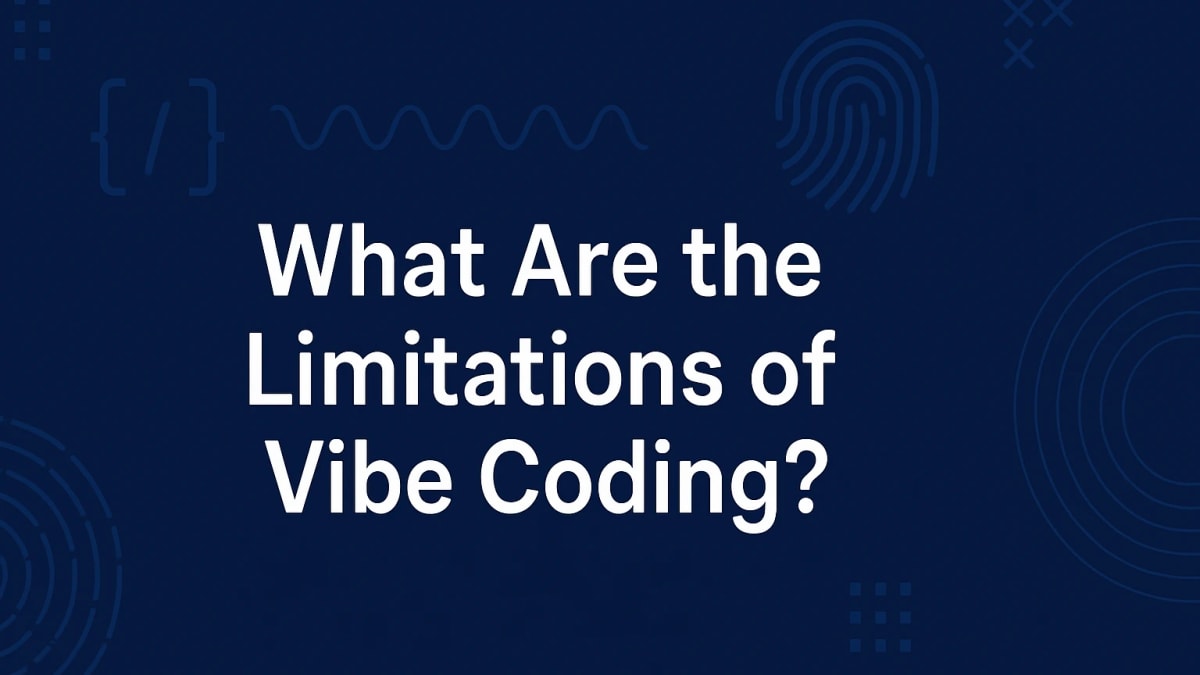What Are the Limitations of Vibe Coding?

Vibe coding is gaining traction across various industries due to its unique approach to coding through emotional and sensory feedback mechanisms. However, while the concept sounds revolutionary, it comes with its set of challenges that organizations and developers need to consider before integrating it into their workflows.
Limited Compatibility With Existing Development Tools
One of the biggest limitations of vibe coding is its lack of seamless integration with popular development environments and frameworks. Traditional coding tools like Visual Studio Code, PyCharm, or Eclipse are not designed to support the sensory and emotional feedback mechanisms that vibe coding relies on. As a result, developers often find themselves having to switch between different platforms or using additional plugins, which disrupts productivity.
Steep Learning Curve for Developers
Unlike traditional programming languages that follow structured syntaxes, vibe coding introduces abstract layers of interaction. New developers or those unfamiliar with haptic or sensory inputs may struggle to adapt. Mastering vibe coding requires not just coding knowledge but also an understanding of emotional mapping, feedback loops, and hardware calibration, which makes the learning process longer and more complex.
Dependence on Specialized Hardware
Vibe coding cannot function optimally without dedicated haptic devices, sensory wearables, or other input/output mechanisms that deliver tactile feedback. These devices are often expensive, not widely available, and can vary in quality. The lack of standardization in vibe coding hardware also creates compatibility issues and increases maintenance costs.
Performance Bottlenecks in Large-Scale Applications
For enterprise-grade software development, vibe coding introduces performance bottlenecks. The additional layers of real-time feedback consume processing power and memory, causing lags, especially in large codebases. This limitation becomes critical in scenarios where speed, precision, and scalability are required, such as in fintech or healthcare systems.
Accessibility Challenges
Vibe coding presents accessibility challenges for developers with sensory impairments. For example, individuals with reduced tactile sensitivity or hearing impairments may find it difficult to benefit from or even interact with vibe coding interfaces. This limitation reduces the inclusivity of vibe coding as a development method.
Difficulty in Debugging and Error Tracing
One of the most significant drawbacks is the complexity in debugging. Vibe coding relies heavily on real-time sensory feedback, which means tracing errors is not as straightforward as reading error logs or stack traces. The abstract nature of vibe interactions can obscure the root cause of issues, making bug fixes time-consuming and frustrating.
Lack of Community Support and Documentation
Since vibe coding is still a nascent technology, there is a limited pool of resources, tutorials, and community-driven support compared to well-established programming languages. Developers often find it challenging to troubleshoot issues or learn advanced techniques without official documentation or a vibrant community to rely on.
Security Concerns
Vibe coding introduces new attack surfaces because of its reliance on sensory and emotional feedback loops. Malicious actors could potentially manipulate haptic signals or sensory feedback to disrupt workflows or introduce vulnerabilities. Traditional code security measures do not always apply effectively to vibe coding environments, requiring specialized security protocols.
Inconsistent User Experiences
The user experience in vibe coding can vary drastically depending on the hardware quality, calibration, and individual sensory perception. Two developers using different devices or configurations may interpret feedback differently, leading to inconsistent code quality or misaligned development outcomes.
Higher Development Costs
Implementing vibe coding requires investment in hardware, training programs, and potentially custom-built development environments. These factors contribute to higher upfront and ongoing costs compared to standard coding practices. For startups and small businesses, this cost barrier can outweigh the potential benefits.
Latency in Feedback Delivery
Vibe coding relies on real-time delivery of tactile, auditory, or visual cues. However, network latency, hardware response delays, and processing time can cause lags in feedback, disrupting the natural coding rhythm and leading to inefficiencies in development.
Limited Use Cases
Vibe coding is not suitable for all types of software development. It shines in areas like game development, VR/AR applications, and interactive media, but proves inefficient or redundant in backend development, data processing, or system programming where sensory feedback adds little value.
Complexity in Collaborative Coding
In collaborative environments, vibe coding introduces complications as each developer’s feedback settings and sensory calibrations are personalized. Aligning these configurations in a team setting is challenging, and can hinder collaboration on shared codebases.
Risk of Sensory Overload
Constant exposure to haptic and sensory feedback can lead to sensory fatigue or overload. Developers may experience discomfort, distraction, or even health issues such as headaches or wrist strain, especially during extended coding sessions.
Challenges in Version Control Integration
Current version control systems like Git are not designed to handle the sensory metadata generated in vibe coding sessions. This limitation creates challenges in tracking changes related to feedback configurations or emotional mappings, complicating merge processes and code reviews.
Conclusion
While vibe coding opens up innovative avenues for interactive programming, the limitations highlighted above underscore the need for careful evaluation before adopting it on a large scale. The technology must address these hurdles to achieve mainstream acceptance and practical utility.

Deepak
Vibe Coder specializing in AI-powered development and software architecture.